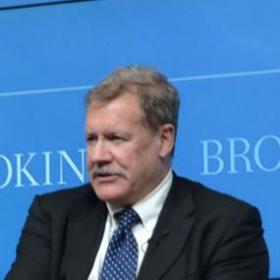
Sevastopol: Europe’s Date with History
Greg Austin wrote this piece for his weekly column in New Europe.
The city of Sevastopol captures modern Europe’s history in a tantalizing way. The city’s past links the easternmost reaches of the continent to its west in a way no other city does. It also speaks to the future in no uncertain terms. Europe has a date with history in Sevastopol.
The Crimea is the farthest east inside Europe that British soldiers fought and died in large numbers, some 5,000 killed in action and some 20,000 dead from disease in Britain’s “Russia War” of 1854-56.
Sevastopol also reveals with sharp clarity the transitory character of political sovereignty. In the Crimean War, among the allies against Russia were two “states” that have since passed into history -- the Kingdom of Sardinia and the Duchy of Nassau.
The Crimean region has been a focal point of invasion and changing political sovereignty over the last millennium. Today, while very clearly a part of Ukraine, the city of Sevastopol and its naval base, like the Crimean peninsula as a whole, have been the subject of some political contest with Russia.
The region and this city have a distinct place in Russian history and psychology. Through 1855 and 1856, Tolstoy achieved his early fame with publication of Sevastopol Sketches, written in large part from the front lines of military service as the city was under siege from France, Britain and Turkey. The Soviet era added even more complex layers of memory and politics. The second siege of Sevastopol, during the Great Patriotic War, lasted some nine months and resulted in Soviet military casualties of around 11,000 killed in action.
Sevastopol is today a “Russian” city. According to the Ukrainian National Census of 2001, the ethnic composition of Sevastopol is predominantly Russian, around 72 per cent, with Ukrainians around 22 per cent.
For now, the political disputes around Sevastopol and Crimea have become quieter. In April 2010, Ukraine and Russia agreed terms to extend the lease on the naval base of Russia’s Black Sea Fleet in Sevastopol until 2042. Ukraine is now led by a political party that more clearly represents the interests of Ukraine’s Russian communities than the rival parties. The government has officially taken its country’s possible membership of NATO off the table.
But Sevastopol remains a beacon warning us of possible dark days in Europe’s future. Under the new agreement, Russia has taken on the responsibility for supporting infrastructure development in Sevastopol and the rest of Crimea. President Medvedev has already ordered planning work to begin. This is definitely good news for local residents and has to be applauded on that basis.
In the longer term, the political significance of this extra-territorial economic planning reach of Russia into the sensitive political region will be determined by what else happens in relations between Russia, Ukraine and rest of Europe.
Here the Russian proposal for a new European security treaty takes on added significance. The case of Sevastopol, which most Europeans and American simply don’t understand, is an important part of the psychology behind Russia’s advocacy of a new security architecture. If we want a guarantee of stability in Europe’s east, then we need to understand that psychology better.
But we also need to respond to it. Europe was not prepared to come to terms with the incipient crisis represented by the political tensions between Georgia and Russia before August 2008. Europe needs to learn from that failure. It needs now to take advantage of the pause offered by Presidents Yanukovich and Medvedev in respect of Sevastopol to negotiate a new security architecture that addresses directly and adequately the “eastern question” of its security -- represented so well by the case of Sevastopol and the Black Sea region.

